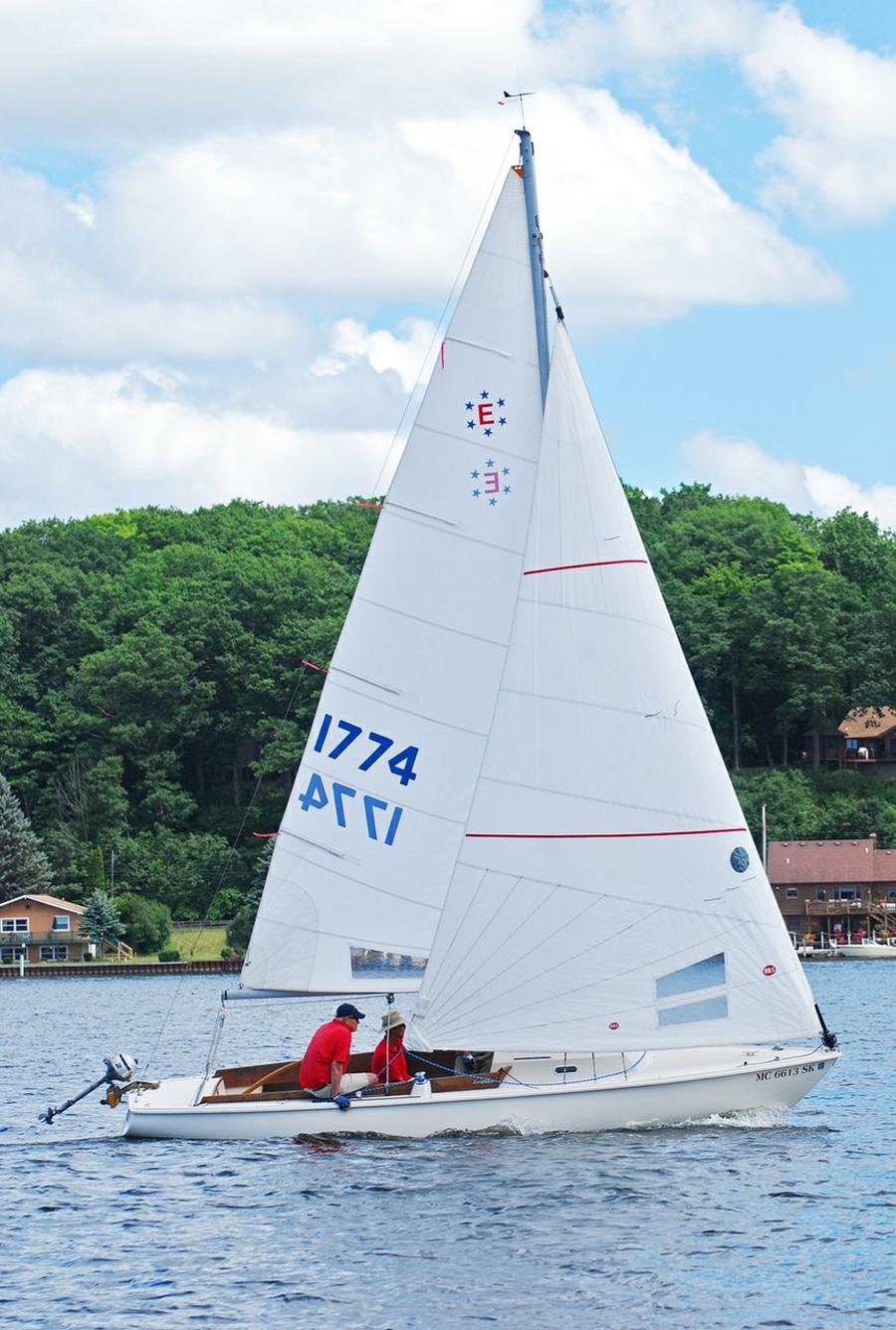Eagle
Hull number 1774
My Ensign Story
by Michael L. Lindvall
Hull number 1774
My Ensign Story
by Michael L. Lindvall

One sweet summer afternoon, my wife and a friend were lounging in two of blue Adirondack chairs that line the front of our little yacht club in Pentwater, Michigan. Though boatless after selling our Tartan 30 several years earlier, we were still members of the club. My wife’s view down the narrow channel that leads out into Lake Michigan was suddenly blocked by flapping white sails, soon to be dowsed, as a sailboat edged dockside. The skipper who climbed up onto the dock a moment later turned out to be a good friend, in fact the architect who had designed the cottage we’d recently built – the very cottage that had necessitated the sale of the Tartan 30. My wife examined the boat he’d just climbed off and said, “Beautiful boat, Norman,” and then added (for reasons that remain a mystery), “Want to sell it?” “Yes,” he answered. And he did. To us.
The “beautiful boat” was Ensign 1774, the last Ensign built by Pearson Yachts. (There is indeed a 1776, but built before 1774 for a buyer who wanted that revolutionary number on his mainsail. There is no 1775.) She was in superb condition with original gelcoat that still shone and recently restored teak seats and floorboards. All “Manana” (as she was then named) needed was some paint in the cuddy, a new outboard, and - when it became clear that club racing was in her future - a new suit of sails. We’d owned no fewer than eight previous sailboats, ranging from an eleven foot Mirror Dingy to that Tartan 30. Never has a boat delivered such pleasure as our Ensign, soon renamed “Eagle.” I’ve thought long about why this should be, as all of those erstwhile vessels were “beautiful boats” as well. For one thing, we soon discovered that the Ensign is a perfectly skewed and happy medium between swiftness and manageability. Ensigns are plenty fast, with especially endearing upwind balance and prowess, but with their substantial and longish keel, present captain and crew with blessedly few of those moments of abject nautical terror that can sometimes punctuate yachting.
We found upkeep on an Ensign is equally manageable. You own an Ensign; it doesn’t own you. There’s enough wood to make her look like a real little yacht, but it’s all nicely hidden from the elements under a boom tent. We found that an outboard auxiliary was a huge relief after the trials of an inboard Atomic Four in the old Tartan 30. Whether they be earlier the Pearson models or the more recent ones from Ensign Spars, Ensigns are notoriously well-built. Many are now a half-century old, still competitive and looking yar.
An unexpected pleasure we discovered after we bought Eagle was club racing in Ensign Fleet 70 in Pentwater, Michigan. Though I had raced in college and (believe it or not) had also raced that tiny Mirror Dinghy, I’m not notoriously competitive. We didn’t buy the Ensign to race, but soon discovered a wonderful comradery among the dozen-plus skippers and their crews in Fleet 70. The competition seemed to be tuned just right – serous enough to be real, but never (or at least seldom) cutthroat. Eagle is the only boat we’ve owned that came with relationships.
But perhaps what has endeared Eagle to me more than anything is the sheer experience she offers under sail. With her low freeboard, modest beam, balanced helm, and eminently lovely lines, she slices water so sweetly. Ensigns move every bit as beautifully as they look. As the late Jack Patterson, founder of Fleet 70 and consummate Ensign sailor, often quipped, “Life is too short to sail ugly boats.”
There’s an old Norse saying that my father once carved into the gunnels of a cedar strip canoe he’d built that goes, “bundin er botlaus madur,” “bound is the boatless man.” Well, we’re happy to be no longer “bound and boatless,” but especially pleased to have been unbound by an Ensign.